The Health Education Assets Library (HEAL) is a collection of over 22,000 freely available digital materials for health sciences education. The collection is now housed at the University of Utah J. Willard Marriott Digital Library.
TO
Filters: Collection: "ehsl_heal"
| Title | Description | Subject | Collection | ||
|---|---|---|---|---|---|
| 1001 |
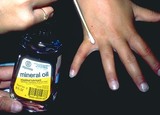 |
Scabies, diagnosis | This demonstrates the application of mineral oil to suspected scabies lesions prior to scraping. | Knowledge Weavers Dermatology | |
| 1002 |
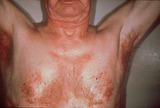 |
Seborrheic dermatitis | Seborrheic dermatitis involving the chest and armpits. | Knowledge Weavers Dermatology | |
| 1003 |
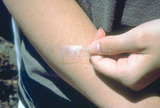 |
Stratum corneum | The stratum corneum, the barrier layer, is very thin, and can be removed with scotch tape and by applying scotch tape to the skin repeatedly for 15 or 20 times. Even though it is physically thin it is a very resilient and effective barrier layer. | Stratum Corneum | Knowledge Weavers Dermatology |
| 1004 |
 |
Milium near the medial canthus of the right eye | Milium near the medial canthus of the right eye. | Knowledge Weavers Dermatology | |
| 1005 |
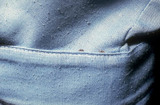 |
Body lice | Body lice often are located in the seams of the clothing. The treatment is simply physically washing the lice off the body, and destroying them within the clothing by washing them in hot water or dry-cleaning them. Itching can be relieved with the use of topical steroids, oral antihistamines, or ora... | Knowledge Weavers Dermatology | |
| 1006 |
 |
Punch biopsy | This demonstrates anesthetizing the skin before doing a punch biopsy. The target is the epidermis and dermis, and the upper portion of the fat, and all those areas should be injected with local anesthetic. | Knowledge Weavers Dermatology | |
| 1007 |
 |
Basal cell carcinoma: excision removal | A layered closure was done using 4-0 absorbable suture as a deep dermal suture, and 4-0 nonabsorbable monofilament suture in a running pattern. Note the wound eversion. | Surgical Methods | Knowledge Weavers Dermatology |
| 1008 |
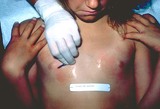 |
Children with scabies | At least 20 red papules are scraped with a #15 blade or a curette. | Knowledge Weavers Dermatology | |
| 1009 |
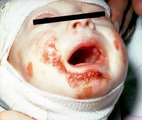 |
Recessive epidermolysis bullosa | Same child with recessive epidermolysis bullosa. The slightest abrasion on the skin would tear the epidermis from the underlying dermis, and this was true of the mucosa as well. The child had broad areas of dermis that were exposed, and the child was treated as a burn victim with Silvadene cream and... | Knowledge Weavers Dermatology | |
| 1010 |
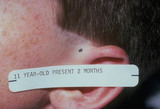 |
Benign nevus in a child | Benign nevus in a child. It has been found that if a nevus grows rapidly in a child that this is the most common indicator of melanoma, and is more important than the usual criteria of mixture of colors and/or jagged border. | Knowledge Weavers Dermatology | |
| 1011 |
 |
Pustules in scalp | Pustules in scalp. There is a type of folliculitis or, some say, a form of acne vulgaris that presents as red papules and pustules in the scalp. Regardless, this generally responds to tetracycline, 500 mg twice daily, or minocycline, 100 mg twice daily. | Knowledge Weavers Dermatology | |
| 1012 |
 |
Excision: suturing vertical mattress | When the long arm (needle bearing end) of the suture is held upward, it forms a natural V, and the needle holder is placed on the inside the long arm of the V. | Knowledge Weavers Dermatology | |
| 1013 |
 |
Ectodermal dysplasia | Ectodermal dysplasia on the vulvae. | Knowledge Weavers Dermatology | |
| 1014 |
 |
Scabies mite | Scabies mite | Knowledge Weavers Dermatology | |
| 1015 |
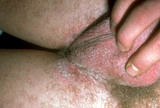 |
Pubic lice | The patient often experiences itching throughout the groin area, and there are often numerous nits in the pubic hair. The lice can range from about the knees up to the eyelashes. It is important to examine the body hair to ensure that all areas that are infested are treated adequately. | Knowledge Weavers Dermatology | |
| 1016 |
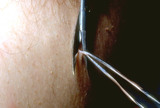 |
Skin tags | Skin tags can be snipped off with scissors. | Knowledge Weavers Dermatology | |
| 1017 |
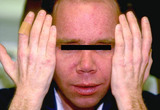 |
Phototoxic eruption in a patient using tetracycline | Phototoxic eruption in a patient using tetracycline. | Phototoxic | Knowledge Weavers Dermatology |
| 1018 |
 |
Oral antibiotic | If a patient has more than 15 red papules and pustules in association with the comedos, then usually an oral antibiotic is required in addition to the previously shown therapy (see Slide 37), and I generally use tetracycline, 500 mg tid, or minocycline, 100 mg bid as the oral antibiotic choice. | Knowledge Weavers Dermatology | |
| 1019 |
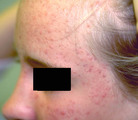 |
Moderate papulopustular acne | Same patient as shown in 64 with moderate papulopustular acne. | Knowledge Weavers Dermatology | |
| 1020 |
 |
Ingrown nail | A broad band tourniquet is applied to the digit. | Knowledge Weavers Dermatology | |
| 1021 |
 |
Excising with scalpel | A partial or full thickness cut is made, and the blade should be kept perpendicular to the skin or angled outward. | Surgical Methods | Knowledge Weavers Dermatology |
| 1022 |
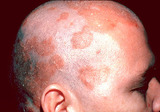 |
Seborrheic dermatitis | Seborrheic dermatitis involving the scalp; for whatever reason the patient shaved his scalp. | Knowledge Weavers Dermatology | |
| 1023 |
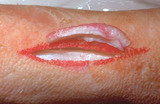 |
Specimen removal | The specimen of skin that is removed should be the same thickness throughout so that there is not an uneven appearance of the skin when the skin is closed with suture. | Knowledge Weavers Dermatology | |
| 1024 |
 |
Chigger mite bites | This patient was thought to be infested with chiggers and had exaggerated insect bite reaction. | Chiggers | Knowledge Weavers Dermatology |
| 1025 |
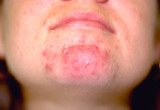 |
Papulopustular flare of acne vulgaris | Close-up of the papulopustular flare of acne vulgaris in this patient. | Knowledge Weavers Dermatology |
